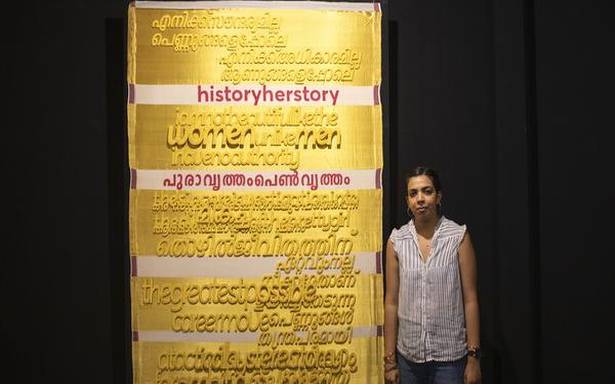ART NEWS
Lakshmi Madhavan’s installation ‘Hanging by a Thread’ at Alappuzha blends art with life
Lakshmi Madhavan’s installation, showcased at the ‘Lokame Tharavadu’ art exhibition in Alappuzha, is an ode to her roots and celebrates the traditional weaves of Balaramapuram
Woven into the warp and weft of each white and gold mundum-neriyathum (traditional garment worn by women in Kerala) are the threads of a narrative that tell the story of weavers and the beauty of their craft. Also caught in the threads of the garment are memories of festivals and celebrations and of the many women who have worn them and still wear them.An art installation by independent artist Lakshmi Madhavan, which is centred on the cream-and-gold fabric, is one of the highlights of ‘Lokame Tharavadu’ (the world is one family), an art exhibition at Alappuzha, curated by artist and Kochi Biennale Foundation president Bose Krishnamachari. Featuring works of 267 artists, including 56 women, from 15 countries, who trace their roots to Kerala, it is one of the biggest art events in India.
‘Hanging by a Thread’, the art installation by Lakshmi Madhavan at the ‘Lokame Tharavadu’ exhibition at Alappuzha
| Photo Credit:
Special arrangement
Being held at multiple venues in Alappuzha, Mumbai-based Lakshmi’s art installation, ‘Hanging by a Thread’, impeccably ties up art with life. Working on the the theme of ‘home,’ her work is a tribute to her paternal grandmother, Sathyabhama. “Being brought up in Mumbai and having studied in different places in India and abroad, home was becoming a difficult space to define or identify. I realised that home for me lay in the folds of my grandmother’s crisp mundum-neriyathum with its faint aroma of starch. This period of lockdown and social isolation have brought into sharp focus the idea of a space called home — a safe space and a comfort zone. For me, all that was symbolised in my grandmother, who lives in Vadakara, Kozhikode. Widowed at an early age, she only wore the settu mundu. She was specific about the colour and width of the kara and the kasavu. This work is my ode to her,” says Lakshmi.Exploring issues of identityThrough the work, Lakshmi has also tried to explore the issues of identity, heritage, culture and space, something she would want to pass on to her two-year-old son. Many of her questions, explorations and answers find expression in her installation at the Port Museum.
Lakshmi Madhavan working on her installation ‘Hanging by a Thread’ for the ‘Lokame Tharavadu’ exhibition at Alappuzha
| Photo Credit:
Special arrangement
Her installation is a tangible piece of art that encapsulates intangible memories and emotions, palpable in the texture, material, colours and use of lettering. The layered work celebrates her roots in Kerala, her grandmother and the work of the weavers in Kerala, many of whom are struggling to keep their legacy alive.Six 10-feet long panels of kasavu cloth hanging on the wall have English and Malayalam words. An heirloom handloom piece, given to her by her grandmother, occupies pride of place. “Around 10,000 letters make up words and sentences that resonate with conversations I have had with my grandmother,” explains Lakshmi. During her summer holidays, the artist remembers speaking to her grandmother in English while Sathyabhama always spoke to her only in Malayalam, even though she could converse in English. “The words and dialogues in English and Malayalam have a significance, it is connected with woman and home in some way or the other. Moreover, they are identity markers in my life, connecting me to my lineage, culture and mother tongue,” says the artist.
Work in progress on the installation ‘Hanging by a Thread’ by Lakshmi Madhavan for the ‘Lokame Tharavadu’ exhibition at Alappuzha
| Photo Credit:
Special arrangement
Having decided on how she would want her art work to be, Lakshmi had a tough time finding weavers to custom-make the panel and convincing them as to why she was doing it. Balaramapuram in Thiruvananthapuram is one of the oldest weaving centres in Kerala, famous for its kasavu-edged cotton cloth. “I decided to get the panels woven there. Phone conversations proved futile. Finally, with less than three months to go for the show, I decided to visit Balaramapuram and meet the weavers,” recalls Lakshmi.Although many of the weavers found it difficult to negotiate the looped and rounded letters of the Malayalam alphabet on the loom, Lakshmi refused to give up on her concept. Finally, she met an elderly master weaver in the weavers’ street in Balaramapuram. She told him the reason behind the concept and why she was keen on doing it to celebrate her grandmother and her legacy. “He understood how passionate I was about the project and after he heard me out, he teared up. He shared his anxieties about the family profession ending with him, as he was not sure if his son was interested in continuing it, though weaving had been their profession for centuries. He wanted to be a part of my project and agreed to go the extra mile.”
Once the panels were ready, Lakshmi spent more than 10 hours each day for nearly a month at her studio in Mumbai to create with gold thread the words in Malayalam that embellish them. The response of viewers has been heartening. While some visitors found it resonating with their memories of home, some felt it captures the essence of the Malayali woman, who is caught between patriarchy and the matrilineal system of inheritance.Mentored by contemporary artist Jitish Kallat, Lakshmi has worked with German artist Bernhard Martin at the Summer Academy in Salzburg and French artist Nicolas Menard in Paris. Lakshmi has exhibited in Mumbai, Kochi, Salzburg, Copenhagen. Her work, ‘I need some air’, was awarded the best installation at Kala Ghoda Arts Festival, 2018.The exhibition is open till June 30.











